
Wearable technology, artificial intelligence, and companion bots—advances in technology are continuing to reach into companion animal care, and Clinician’s Brief is exploring CES 2024 to report on technologies you might soon see—or be asked about by pet owners. This week, Clinician’s Brief editor, Alyssa Watson, DVM, will be providing a distinct veterinary perspective on medical innovations and pet tech featured at CES 2024.
What Is CES?
Formerly known as the Consumer Electronics Show, CES is the largest trade show in the world for consumer technology, hosted annually in Las Vegas. This year’s expo, held January 9-12, 2024, features more than 4,000 exhibitors from around the globe and will showcase medical innovations, health monitoring and tracking technologies, automation solutions, and more.
Medical Technology & Wearables
DoseRx1, a 3D printer for pharmaceutical compounding, stood out as the most impressive device we saw at CES 2024. This innovation has potential to both simplify and standardize in-clinic compounding of medications. For us veterinary professionals, the need to adapt existing human drugs to meet the specific requirements of our veterinary patients is a common challenge, and any tool that facilitates this process is highly welcomed.
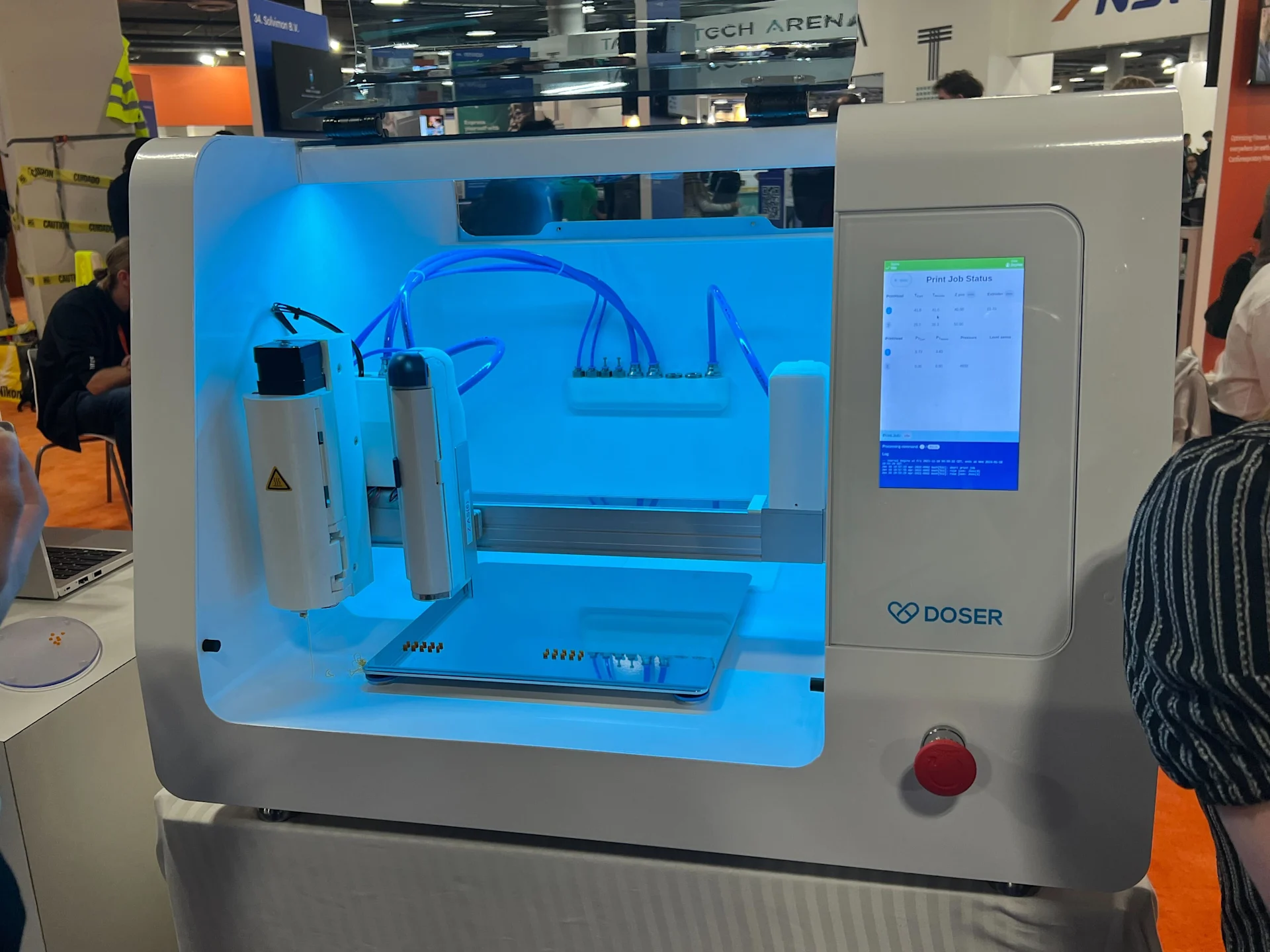
One noteworthy feature of the printer is the ability to create dual medications within a single pill. This means medications like trazodone and gabapentin can be compounded, each at a dosage tailored to your patient's specific needs. Currently, the printer can combine a maximum of four medications. This versatility opens up new possibilities for customized treatment plans.
Beyond compounding, Doser’s 3D printer could help manage inventory and reduce waste of expired drugs. Veterinarians could utilize this kind of device to produce medications for rare conditions or emergencies, ensuring that resources are allocated efficiently and drugs are prepared only when necessary, not only streamlining operations but also addressing the challenges of managing inventory for specialized cases.
This tracking suite includes three devices to monitor a dog’s activity, rest, and feeding information: an activity tracker, a smart bowl, and a home hub. The activity tracker monitors the dog’s daily energy output, and the smart bowl includes visualized indicators to suggest portions. Data from these trackers is continually collected from the home hub, which connects to Wi-Fi and, through an ilume app, provides insights based on information gathered from the other two devices.
Among the array of wearable tracking devices and smart feeders, this product caught our attention for its combination of both. As overfeeding and obesity is prevalent in dogs, a device that offers pet owners insights into their pet's real-time caloric needs could be beneficial.
While pet owners frequently seek advice on appropriate feeding amounts, many lack awareness of their pet's food caloric density and may be uncertain about the specific food their pet eats. This product presents a potential solution by facilitating a more personalized diet plan that is easy for pet owners to follow, eliminating confusion about the quantity of food to be administered in cups. Additionally, it’s possible the product could be used in various scenarios, such as tailored feeding recommendations for pregnant or nursing animals, those recovering from surgery, or pets suffering from chronic illnesses such as kidney disease.
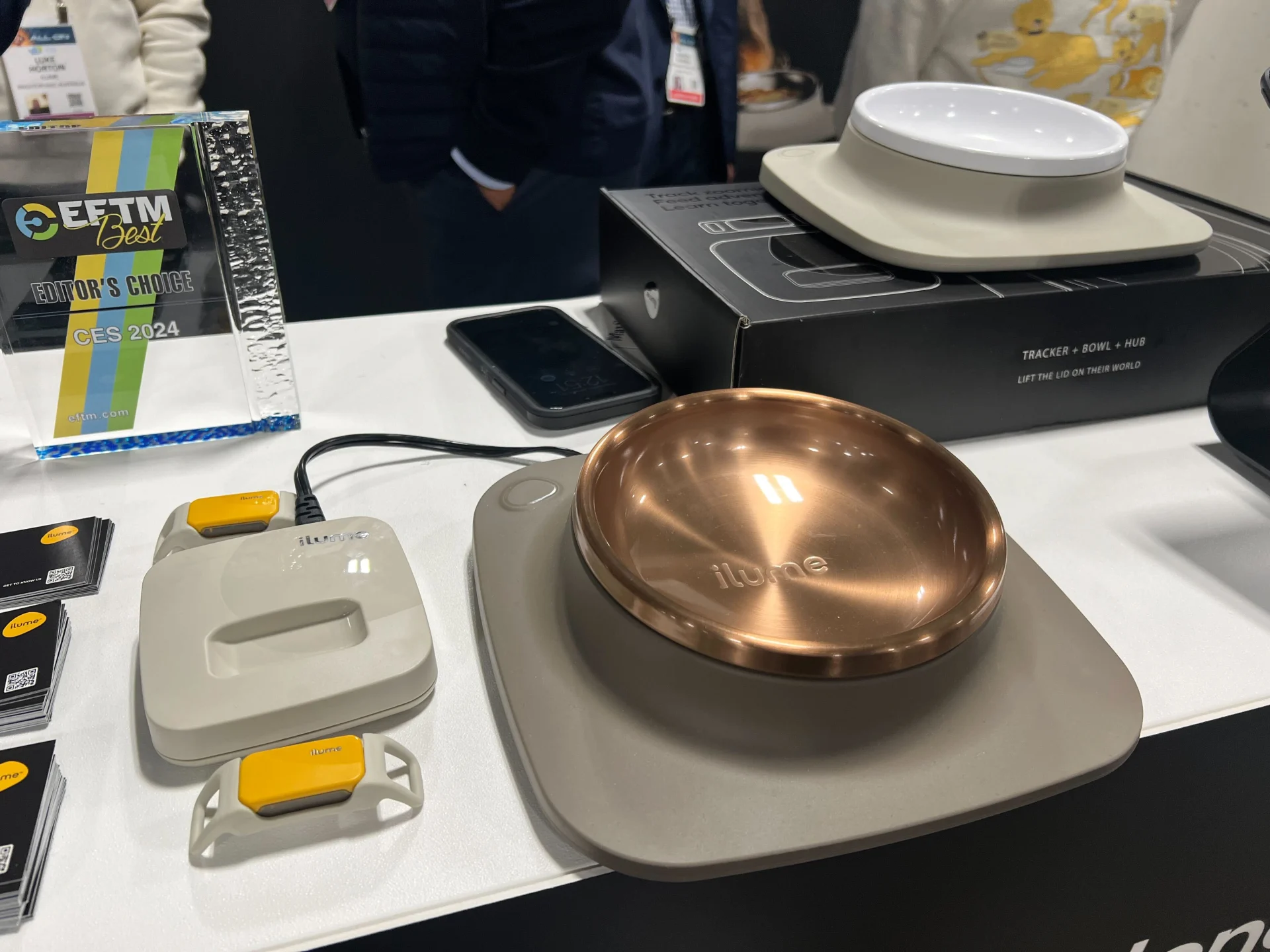
Among the array of wearable tracking devices and smart feeders, illume caught our attention for its combination of both.
Smart collars for dogs, similar to smartwatches for humans, offer insight into its wearer’s basic health stats: resting heart and respiratory rates, sleeping habits, activity levels, and more. A notable trend in smart collar devices is their diminishing size, coupled with extended battery life, enabling the incorporation of features such as GPS tracking capabilities.
One of numerous smart collars featured at CES 2024, the Invoxia collar includes GPS and a specific cardiac monitoring system, providing a 2D visualization of its wearer’s cardiopulmonary system.
Functions of the Invoxia collar that stand out are heart rate and sleeping respiratory rate monitoring. Research indicates that monitoring the sleeping respiratory rate (SRR) is a highly sensitive method to assess the effectiveness of drugs in controlling a patient's heart failure. These features could provide insights into the patient’s response to therapy and aid in refining treatment plans for optimal results.
Despite these advancements, as a veterinarian, I’m concerned that many of these devices are still too large and heavy, particularly when considering the comfort and suitability for toy breeds and feline patients who often suffer from heart disease.
Novosound’s flexible ultrasound sensor was one of the most intriguing innovations we encountered at CES 2024. In contrast to traditional solid material ultrasound sensor probes, Novosound’s thin-film technology allows the ultrasound sensors to be wrapped around surfaces, offering a level of flexibility that was previously unattainable.
The apparent scalability of these ultrasound sensors is impressive: in a product demo, a tiny sensor easily fit into the palm of my hand. Remarkably, the company claims to have an even smaller sensor designed to fit inside a human blood vessel. This level of miniaturization opens up possibilities for applications in very small patients, especially in the realm of exotic animals.
The product representative mentioned that the company is actively exploring partnerships with veterinarians in Europe to develop products tailored to our field. Their genuine excitement about the possibilities for advancing veterinary care using this technology is encouraging.
This device, with an intriguing appearance of just the bell of a stethoscope without tubing and earpieces, functions similarly to a traditional stethoscope, facilitating heart auscultation. The company, SmartSound, claims the device is optimized for use on the haired skin of animals. The “bell” records an audio clip and following the auscultation, the clip is analyzed by an AI program to detect abnormalities, such as arrhythmias and murmurs, as well as calculate a heart rate.
Booth representatives noted that WithaPET’s current focus is canine mitral valve disease, particularly in the early detection of dogs with stage B2 heart disease. Imagery at the booth showed a dog wearing the device with a strap, reminiscent of a Holter monitor, but without the bulk. What sets this device apart is the opportunity for at-home monitoring by pet owners. Clients can be educated on how to position the device for optimal sound capture, enabling pet owners to actively participate in their pet's care.
Additional AI Products
Generative AI is a growing arena of technology, represented across hundreds of exhibitors at CES 2024. Many of these AI-based innovations are poised to impact medicine, in both human and animal healthcare.
Some of these technologies, such as chatbot-type services that aim to offer AI-informed predictive results on the likelihood of disease or conditions present in the image samples or other information provided by the user, currently offer little information to back up their claims.
However, these somewhat dubious concepts do not necessarily negate the potential utility of predictive technologies in veterinary medicine, and are not poised to replace clinicians.
Listen in as Dr. Alyssa and Dr. Beth discuss the potential benefits and limitations of AI applications in veterinary practice. Watch the podcast here.
As research on these technologies expands, more sophisticated technologies with immediate utility for veterinarians will emerge. Some innovations, such as AI-assisted ultrasound analysis and smart healthcare devices (eg, WithaPET, above), may offer practical application before we know it.
Following are two of the more promising AI-based concepts we explored.
DumboCam
Still in its early stages of product incubation and demonstration (the developers do not yet have a product website), DumboCam automates positive reinforcement training and enables pet owners to train dogs remotely. The suite of technology includes a camera, a treat dispenser, a mat, and an app. Pet owners can select behaviors to train via the app; the camera recognizes when the dog demonstrates the desired behavior, releases a pleasing sound (eg, a chime or click), and dispenses a treat. Trainable behaviors include appropriate elimination, crate resting, placing toys in a desired location (eg, a basket), and more.
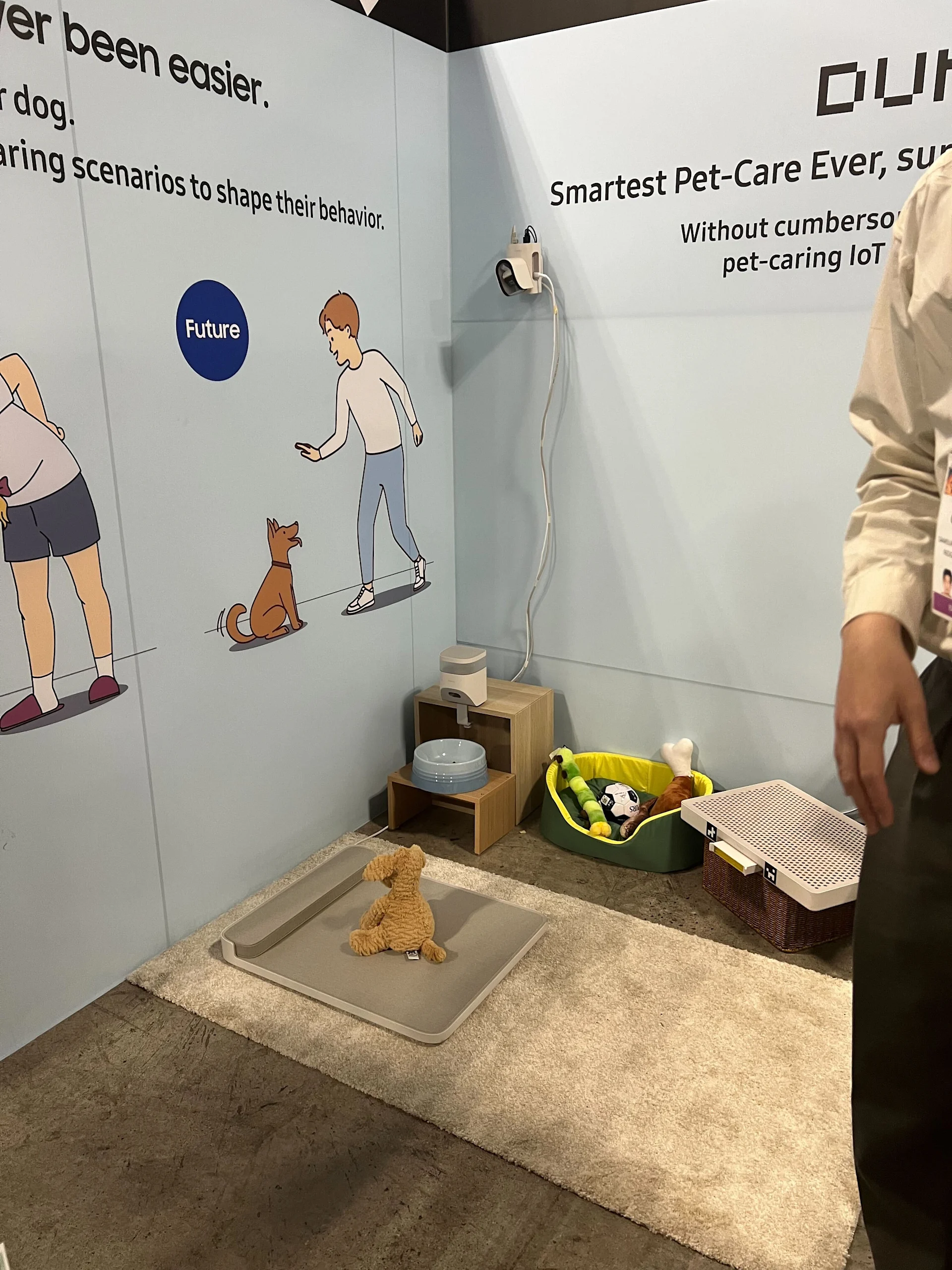
DumboCam's suite of technology includes a camera, a treat dispenser, a mat, and an app.
DumboCam offers an innovative application of AI for pet training and positive reinforcement. The continuous monitoring provided by the camera allows for more consistent rewarding of desired behaviors as compared with human intervention. The developer we spoke to shared an example of training his own pet to not only use a puppy pad but to target the very center of the pad (as opposed to the edges).
In addition to its training capabilities, DumboCam’s app extends control to other smart devices in the pet's environment. For instance, it can turn off a lamp when the animal enters the crate to sleep or activate a warming pad when the dog lays on a mat. These integrations enhance the product's utility by offering a broader range of functionalities beyond training, contributing to an enriched and responsive pet environment.
Recently made available in the US, France-based Neovoice is an app that uses AI to analyze moods exhibited in user-provided photos of a pet. Designed for pet owners, the app’s most potentially valuable veterinary application could be detecting signs of pain in pets. The use of pain scoring systems in both dogs and cats is well-established in veterinary practice settings. However, clients are often unaware of their pet’s discomfort, even when presenting pets exhibiting signs of pain, such as limping. An app that could help alert pet owners to potential signs of pain in their companion animals could encourage pet owners to seek veterinary care sooner. Although the company’s focus is currently on dogs, booth representatives noted an interest in expanding the technology to include cats in the future.
Home Tech
Catlink, Litter Robot, & Pawbby
A variety of automated, self-cleaning litter boxes, a technology many American pet owners may already be familiar with, were on display at CES 2024.
The Litter Robot by Whisker and the Shanghai-based Catlink each feature a globe-shaped litter box that rotates to sift litter each time the box is used, depositing urine and feces into a waste drawer below. Weight sensors detect when a cat enters and exits the litter box, signaling the litter-sifting technology. Pawbby also automatically self-cleans, disposing of waste into a separate chamber.
Each self-cleaning litter box we looked at featured relatively minor, but distinct, characteristics. The Litter Robot box, for instance, includes a mechanism to bag feces and urine clumps, sealing the bag prior to pet owner removal. In contrast, the Pawbby box employs eco-friendly flushable litter and utilizes UV light for box sanitation.
Each of the litter boxes we viewed claims to differentiate between individual cats in multicat households, although this identification is typically based on weight detection rather than employing advanced AI facial recognition software. However, because the litter is fresh each time a cat enters these automated self-cleaning litter boxes, these devices can potentially eliminate the need for multiple litter boxes for multicat households.
In addition to their primary function of automated cleaning, these litter boxes hold potential for health monitoring in cats. With app connections that notify pet owners when the litter box is used, these devices could serve as a tool for tracking urination and defecation frequency, aiding in the early detection of conditions like urinary disease or constipation. This is particularly relevant for multicat households in which pinpointing the cat with a specific issue can be challenging.
Furthermore, there are potential public health implications associated with the use of these litter boxes. By reducing direct contact with cat urine and feces, there may be a lowered risk of exposure to zoonotic diseases for owners.
We looked at two distinct pet door products at CES 2024—one designed for cats and the other tailored for dogs. Notably, the cat door stood out as one of the rare feline-specific products that wasn’t a litter box.
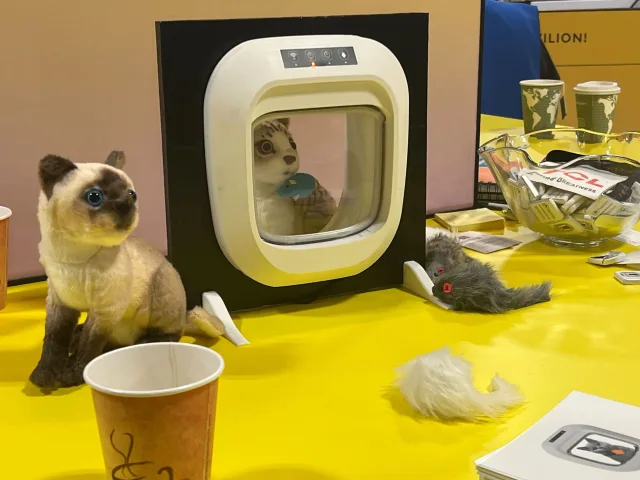
Flappie is a cat door designed to prevent cats from carrying mice or other unwanted critters into the home.
Flappie is a cat door designed to prevent cats from carrying mice or other unwanted critters into the home. Two components control the cat flap: Integration with the cat’s microchip prevents access for other animals, while a small camera employs AI to analyze whether the cat is carrying anything in its mouth, restricting access if the cat attempts to bring in undesired “gifts.” With a connected app, pet owners can view a video stream from the integrated camera and receive notifications when their cat enters and exits the home.
It's worth noting that during our discussion with the developers, they humorously shared their initial challenges. Cats, being clever, adapted to Flappie’s restrictions by placing their prey on the ground, making eye contact with the camera, and swiftly grabbing the prey when the door opened. In response, the developers adjusted the door's programming to delay opening after detecting prey in the cat's mouth. Subsequently, the cats learned to set down the prey well out of the camera's range to gain access.
While Flappie’s unlocking mechanism connects to the pet’s microchip, Pawport’s dog door operates by linking to a wearable device on the dog's collar rather than the animal's microchip.
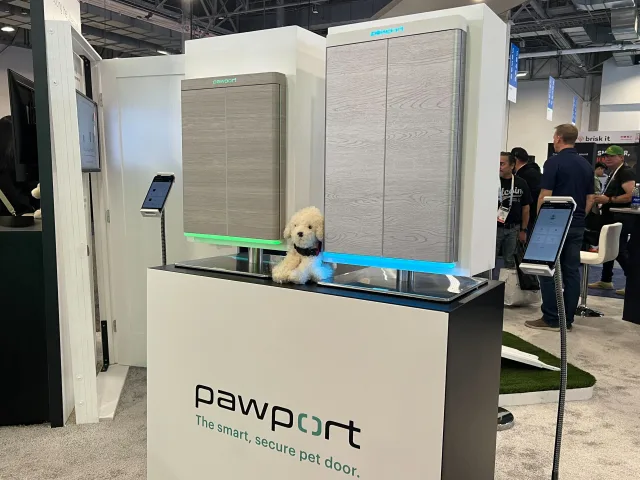
Pawport is designed to slide directly onto existing pet doors.
The Pawport device slides directly onto existing pet doors and, through a connected app, allows pet owners to lock and unlock the door remotely, create schedules for individual pets, and track and monitor entries and exits.
One limitation I noted was that Pawport’s developers have not addressed the issue of a household cat potentially escaping when the dog uses the door.
Nevertheless, both pet doors share the common benefit of preventing unwanted animals or intruders from entering the home and the security of using an app to remotely access the door or set a schedule for the pet.
ORo is a robotic companion for dogs, with the capability to record video and engage in rudimentary games like fetch and laser tag. The manufacturer, Ogmen, claims that the robot can also monitor behavior and assist with training.
The ORo robot maps and learns the home layout, and, according to developers, uses AI to detect signs of restlessness in your dog, prompting the robot to initiate interaction. At Ogmen’s booth, we viewed a video demonstration of ORo playing fetch with a dog. In this demonstration, the robot launched a tennis ball and the dog retrieved it, dropping the ball into a compartment at the rear of the robot. We assume that a dog would need prior training to understand the game and where to place the ball for continuous play with ORo.
Notably, the robot is designed with dogs in mind, featuring smooth curved surfaces to prevent trauma and discourage chewing. The robot appears to operate quietly, with consideration for the sensitivities of dogs and cats.
Similar to robotic vacuums that have become more commonplace in the US, the robot automatically docks itself to recharge. A separate device (sold as a package with the robot) automatically dispenses food and medication at programmed times, and also includes a camera for monitoring. Both the robot and dispenser devices are connected to an app. As robots become more prevalent in households, it’s likely that additional features will be introduced.
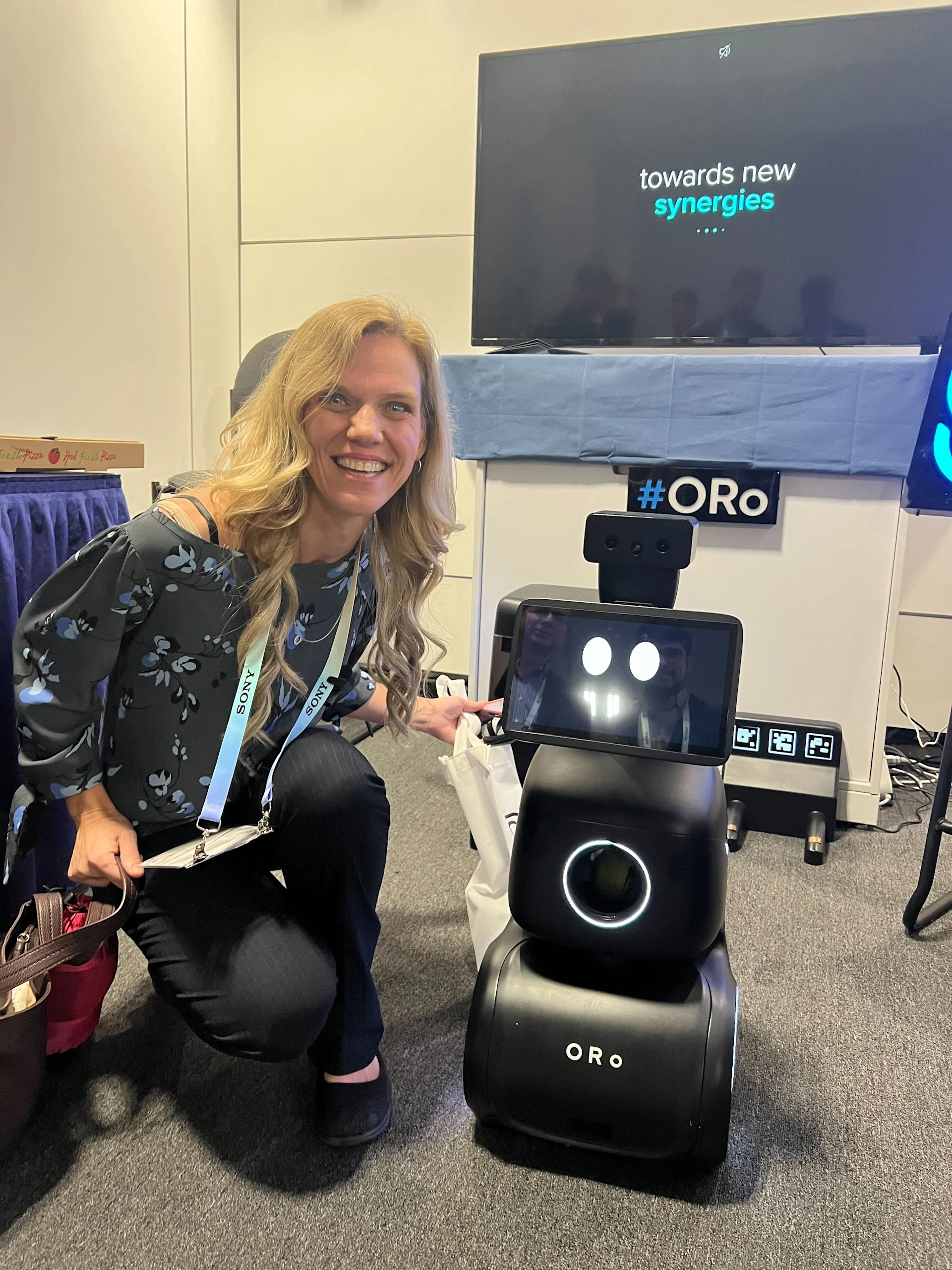
ORo is a robotic companion for dogs, with the capability to record video and engage in rudimentary games like fetch.
Fun & Games
The manufacturer of TheButter, a variation of puzzle feeder that incorporates tactile and auditory elements, claims to allow dog owners to challenge their canine companions through music. After a dog “plays” a tune on the device, the device dispenses food or treats in specified increments. A Wi-Fi connection enables pet owners to track their dogs’ performances and create playlists for extra challenges.
This device has the potential to provide enrichment for dogs. Research indicates that enrichment activities can contribute to slowing age-related cognitive decline in animals and foster a stronger human–animal bond. The incorporation of diverse sensory experiences adds to the product's potential as an engaging and beneficial tool for canine enrichment.
Dogsplay is a display similar to a tablet device intended specifically for dogs, including a stand that allows pet owners to place the display at their pets’ level.
Pet owners may be familiar with dog- and cat-oriented “TV” channels that stream video recordings of birds, squirrels, and more: Dogsplay combines this kind of programming with real-time video chat features found in other popular pet devices, allowing pet owners to check in and talk to their pet while outside the home using an app. Dogs and cats engaging with television screens is a well-known phenomenon, observed in many households. (For instance, my own Great Dane barked at every dog she saw on television, including cartoon characters like Scooby-Doo.)
The video-chat feature, which is likely to appeal to pet owners, acknowledges the growing trend of technology that facilitates interaction with pets, offering a potential avenue for owners to connect with their animals remotely.
Lastly, this product adopts a distinctive approach by claiming to optimize 2D images for canine sight with a “dogfilter,” although the research supporting this claim remains unclear.
Listen to the Podcast
Dr. Alyssa talks about her experience at CES in this episode of the Veterinary Breakroom.